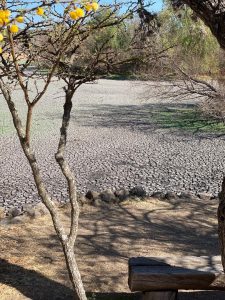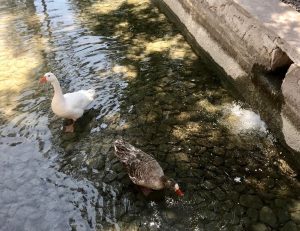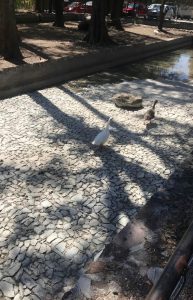Last Sunday when my friends Kharin and Ruth hiked El Charco del Ingenio (The Mill Pond), home of San Miguel de Allende’s exquisite botanical gardens and nature reserve, they discovered to their shock that most of the enormous reservoir there had gone dry. Its bed was cracked and veined, baked in the sun:

And last week, when I walked to one of my favorite spots, the duck pond near San Miguel’s art and design center, Fabrica la Aurora, I saw that the pond was mostly dry. Instead of gliding gracefully in the water, as I’ve always loved watching them do, the more than a dozen ducks and geese were waddling disconsolately along the length of the pond’s dry stone bottom:
What is going on? I had to wonder. Could this possibly be normal? Should I – and these ducks and all the living beings in the nature reserve as well as in this community — panic? Is this a life-threatening drought? Is climate change to blame?
Yes, we’re nearing the end of the dry season here in this region of Mexico, and the earth is naturally parched. There’s been no rain since about October, and it won’t rain again for a couple of months. To some extent this seems natural to me because I’ve lived for many years elsewhere in the tropics.
Growing up in the northeast United States, I experienced all sorts of precipitation all throughout the year every year. But I subsequently learned that regions in what is known as the tropical rain belt have just two seasons – wet and dry – which last for months on end. This includes Mexico.
According to Wikipedia, “The rain belt reaches roughly as far north as the Tropic of Cancer and as far south as the Tropic of Capricorn. Near these latitudes, there is one wet season and one dry season annually. At the equator there are two wet and two dry seasons, as the rain belt passes over twice a year, once moving north and once moving south. … During the dry season, humidity is very low, causing some watering holes and rivers to dry up.”
One example: Gabon, where I served for two years in the U.S. Peace Corps from 1996 to ’98, is a small African country, about the size of Colorado, that straddles the equator. It has year-round 100+-degree F. temperatures, close to 100 percent humidity, and an average annual rainfall of more than 120 inches. The driest months are June, July, August, and early September. The rest of the year is muggy and scorching, with heavy rains from evening until morning.
In Gabon I used to label the seasons by the consistency of the soil: It was either the thick-squishy-mud season or the red-swirling-dust season. There was no in-between.
But this current situation here and now in San Miguel de Allende, Mexico, seemed alarming to me. (Was it the wicked hand of climate change at work?) So I asked an expert, Rob Lerner, who is a board member and technical advisor to the local nonprofit Caminos de Agua, whose mission is to improve human health and community well-being through adequate and affordable access to clean water, to briefly enlighten me.
“The Charco going dry at the end of the dry season is nothing new,” Rob informed me. “Droughts happen. This season may have been the driest in decades, but no single year or weather event can be attributed to climate change – only that climate change makes such outcomes more likely.”
In other words, I surmised, we’ll live – at least for the near future.
But now when I look more closely at Kharin’s recent photo taken at El Charco, I see something else. I see it as a metaphor for the way I (and perhaps others?) feel at times, inside of ourselves: desiccated, dusty, cracked open. Lately, my heart, soul, and creative juices feel as if they’ve gone dry. I ask myself, Why? And I get no solid answers.
So I tell myself, It’s just the dry season. Don’t worry. You’ve lived through enough dry seasons to know this will pass. The rains will come. Hang on.
Everything, King David’s son wrote, has a season, and every season has a purpose (Ecclesiastes 3:1-11). God, says Solomon, “hath made every thing beautiful in his time” (verse 11).
I returned to the duck pond this week to see that water is now being pumped into it. I stood for a long time at the fence, watching the ducks happily wade, ankle-deep, in their pond, patiently waiting for it to fill up. This gave me hope.

~ ~ ~ ~ ~ ~ ~
For more about Caminos de Agua, go to: https://caminosdeagua.org/.
For more about the botanical gardens at El Charco, go to: www.blog.bonnieleeblack.com/starship/
For more about the duck pond near Fabrica la Aurora, go to: www.blog.bonnieleeblack.com/something-about-ducks/


